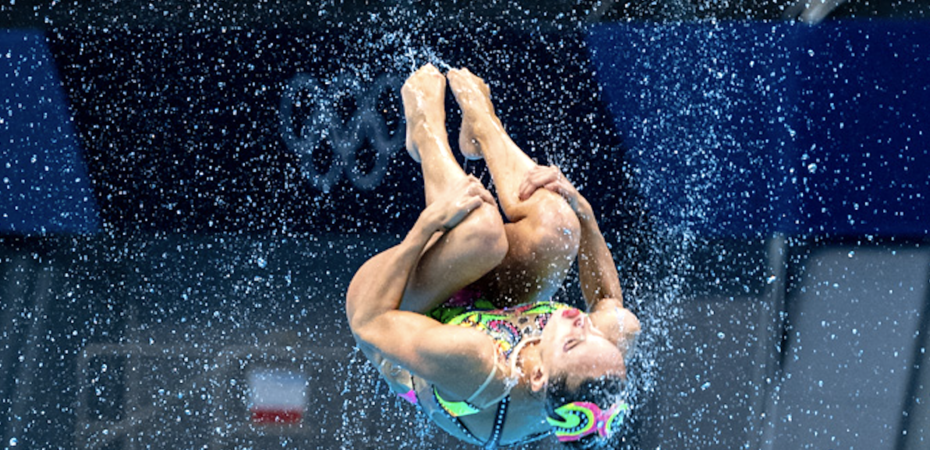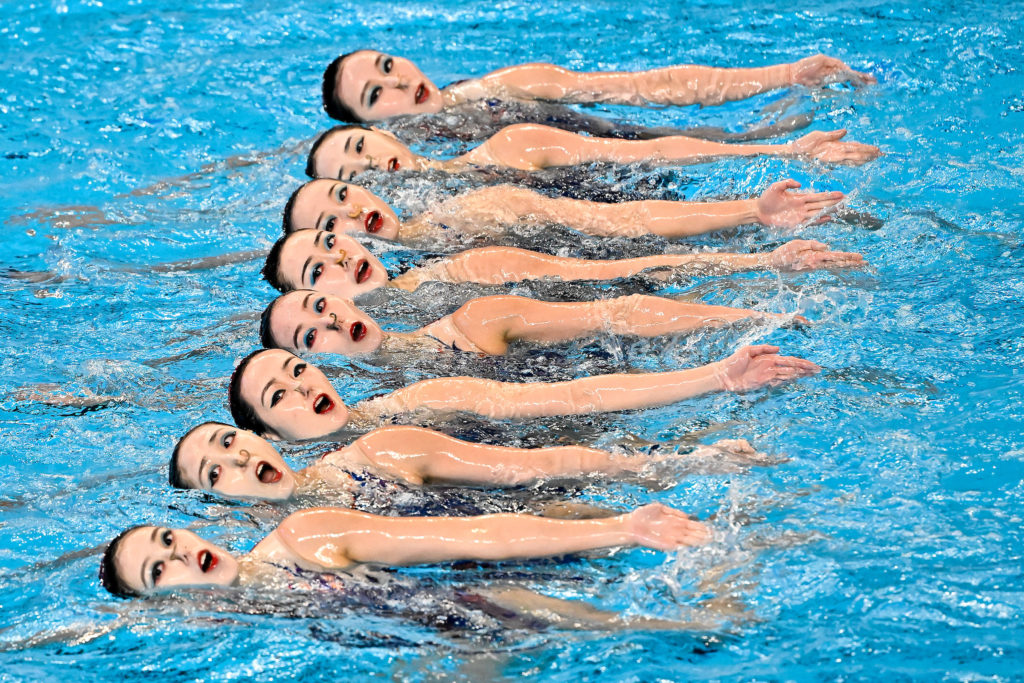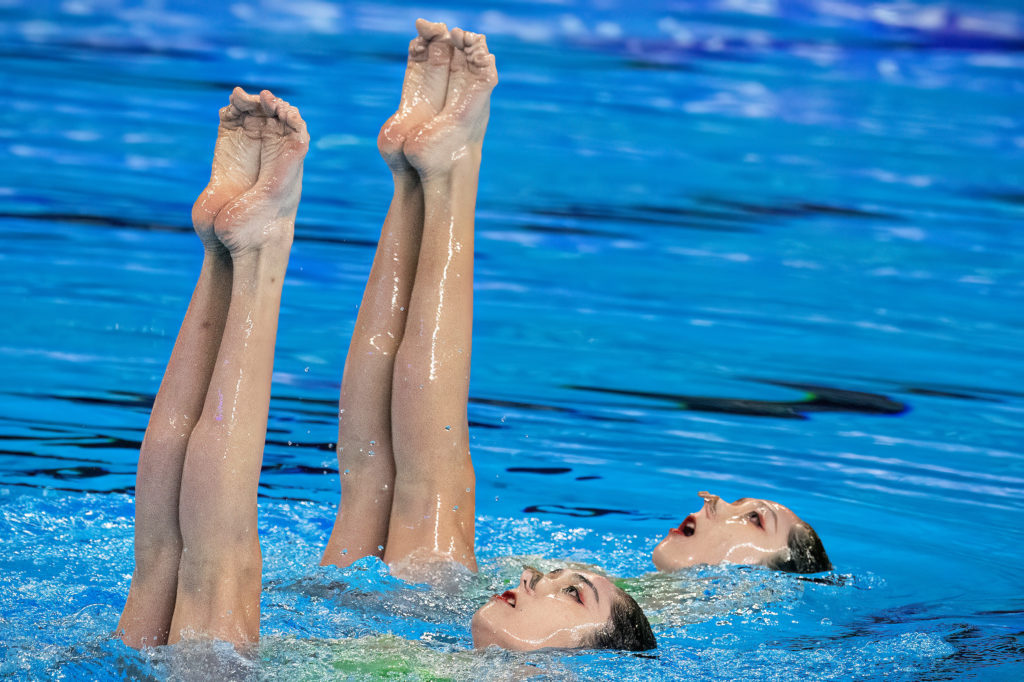New to artistic swimming or only watch the sport when it comes around at the Olympic Games? Then this article is for you. If the last time you watched artistic swimming was three years ago in Tokyo, just know that it has changed drastically.
Who will compete in Paris?
96 athletes from 18 countries will participate in the 2024 Olympic Games in artistic swimming. 10 nations will compete in the team events, and 18 in the duet events.
All 10 countries that have qualified a team – which are made up of eight athletes – are also automatically entered in the duet. The duet is made up of two athletes amongst those eight. Nations who have only qualified in duet can enter a maximum of two swimmers for the Games.
The countries that will compete in team are Australia, Canada, Egypt, France, Italy, Japan, Mexico, People’s Republic of China, Spain and the United States of America.
The countries that will compete in duet are Australia, Austria, Canada, Egypt, France, Great Britain, Greece, Israel, Italy, Japan, Mexico, the Netherlands, New Zealand, People’s Republic of China, Republic of Korea, Spain, Ukraine and the United States of America.
You can read more on who qualified at this page, or check out our previews of each of the 10 nations that have qualified a team.
How old must you be to compete at the Olympics?
Artistic swimmers must be 15 years old, or turn 15 in the Olympic year, to be eligible to participate in the Paris Games.
The youngest athlete to compete in Paris will be 16-year-old Higa Moe of Japan, while the oldest is 34-year-old Nuria Diosdado of Mexico, already a three-time Olympian. Both will appear in the duet and team events.
Why is artistic swimming a female-only sport?
Actually, it’s not. Men have been allowed to compete on the world stage since 2015, and more events have been opened to them ever since. They can now participate in the solo, mixed duet and team routines in all major international competitions where these events are on the programme.
In late 2022, it was announced that men would be able to swim at the Olympic Games in the team event, starting in Paris 2024. However, all 96 artistic swimmers you will indeed see in Paris are women.
Unfortunately, no male artistic swimmer made the cut for their respective team’s rosters. We will have to wait until Los Angeles 2028 to hopefully see men compete at the Olympics in artistic swimming.
What events will you see in Paris?
Artistic swimming only has two medal events in the Olympic Games: team and duet. The team competition is first on the schedule and consists of three routines: technical team, free team, and acrobatic team. The latter is included on the Olympic programme for the first time.
All routines are of slightly different lengths and have different requirements.
The technical team routine is the shortest (2:50 min) and stands out for its five “technical required elements”. These technical elements are the same for everyone, cannot be changed, and must all be done at one point in the routine.
The free team is the longest at 3:30 min. As the name indicates, countries have full freedom on what they show in all hybrids – a hybrid is a sequence of two or more leg movements performed while the swimmer is underwater – and acrobatics, although there are limits as to how many they can do.
The acrobatic team routine lasts 3:00 min, and is obviously all about acrobatics. Each team has to showcase seven acrobatics – whether it’s high-flying double tucks, steady platforms showing flexibility, or a swimmer twisting high over another. In this routine, only the acrobatics count towards the difficulty score.
In duet, there are only two routines: technical and free. The former lasts 2:20 mins and must include five technical required elements as well – albeit different ones than in the technical team. The free duet is slightly longer, lasting 2:45 min, and is also a mix of free hybrids and pair acrobatics.
How are the medals awarded?
The final rankings in the team event will simply be determined by adding the scores of the Technical Team, Free Team, and Acrobatic Team routines. The team medals will hence be given out on August 7th after the acrobatic team event.
The rankings in the duet event will be determined by adding the scores of the Technical Duet and Free Duet routines. The duet medals will awarded on August 10th after the free duet competition.
How does the scoring work?
Since the 2023 season, artistic swimming has undergone a major and complex overhaul in its rules and scoring system.
Firstly, routines are judged differently. In the last Olympic Games, the score used to be determined by three parts: execution, artistic impression and difficulty. Now, it is determined by two: elements and artistic impression.
To come up with the former, each routine has a set number of elements. Elements can be the technical required elements, free hybrids, and acrobatics. Each of these elements has a Degree of Difficulty (DD).
Every movement the athletes do with their legs during a hybrid, a technical required element, or during acrobatic moves now has a value. All of these add up to a DD for each element, and ultimately a total DD for the routine. As the swimmers go through each element in the water, they are awarded scores for execution, which all ultimately add up to obtain the elements score.
With the DD coming into play, artistic swimming has moved into an open-ended scoring system, and the routine scores are not capped at 100 points anymore.
If you’d like to know more about the new rules or get more in depth about the difficulty of elements, you can check out a few of our articles here.
Finally, the teams have to submit their intended routine and difficulty prior to competing. If what they do in the water differs from that submitted list, they will be penalized.
What is a basemark in artistic swimming?
This might be the first time you even see it, but the word “basemark” will come up a lot, whether you’re watching on TV or in the pool itself.
A basemark is essentially that penalty that a team receives when it doesn’t successfully execute the difficulty it had declared beforehand. A basemark is more or less costly depending on the element on which it falls.
When a team receives a basemark, it means the DD of the element has been lowered to either 0, 0.1 or 0.5 depending on what kind of element. Obviously, going from a 14.5 DD to a 0.5 will significantly hurt the total routine score. And two, three, or more basemarks quickly add up and may send you to the bottom of the rankings.
A basemark could come after an obvious mistake, such as an acrobatic completely failing, or it could also be because of something much more subtle that will be hard to spot for most people.
Surely, basemarks will play a huge role in who gets to step on the podium, or rather, who doesn’t, in Paris. Expect high bursts of joys as the scores are announced if a team achieves a clean, basemark-less swim.
Who are some of the favorites in the team event?
The recent rule changes have made artistic swimming much more unpredictable, making the Olympics anyone’s competition to win versus a battle of a handful of favorites.
However, should the People’s Republic of China perform to its capabilities, the gold should be its to lose. The Chinese won gold in all five Olympic routines at the last World Championships in Doha in February, displaying great technical mastery, fabulous execution, and compelling artistic impression.
Japan, Spain and the USA all came away with at least one team medal in Doha, and will certainly be strong contenders for the podium in Paris. Each has different strengths and weaknesses; for example, Japan and Spain are tremendous in technical team, while the USA is astounding in acrobatic team.
Of course, do not count France out. The nation hasn’t competed much this year, skipping the World Championships, European Championships and most World Cups to fully peak and make its mark at these home Olympics.
Mexico has also meticulously paced itself, and notably won two gold in the team events in a stacked field during the Paris World Cup, the Olympic test event, last May.
Ukraine, bronze medalist in Tokyo, did not qualify in team.
Who are some of the favorites in the duet event?
The new rules of artistic swimming are much more demanding for the athletes and coaches than ever before. As a result, the countries only qualified for the duet event have had a certain advantage in terms of preparation, with only two routines to work on instead of five.
Numerous duets from Europe will be ones to watch in the hunt for medals. Particularly, keep an eye out for Austria, Great Britain and the Netherlands, all on the World and European podiums over the last two seasons. They have demonstrated great consistency meet after meet and showcase balance between difficulty, execution and artistry.
The duet of Israel is also coming off two bronze medals at the European Championships, and Ukraine just had one of its best swims about a month ago at the last competition before the Games.
Of course, some duets who do take part in team routines are also strong contenders for the podium, such as the People’s Republic of China, who comes in as the reigning World Champion, or the duet of Canada who’s going all-in on difficulty. The duet of Spain is also one to watch, as it won bronze in Doha, and always showcases great artistic impression.
All the information you need to follow the competition is available here.
ARTICLE BY CHRISTINA MARMET
Cover photo: Deepbluemedia
If you’ve enjoyed our coverage, please consider donating to Inside Synchro! Any amount helps us run the site and travel costs to cover meets during the season.



